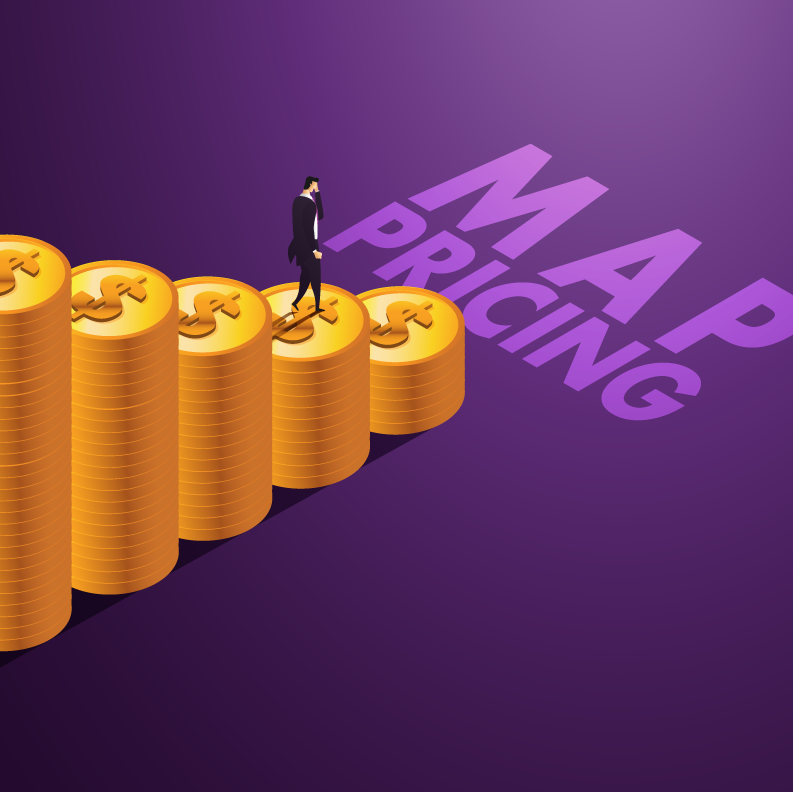Brands and retailers know better than anyone — one bad apple can ruin the whole bunch.
In a competitive market where consumers can compare and shop for the best prices in an instant, sellers are incentivized to offer the most competitive prices. But pricing is a delicate dance between brands, their retailers and consumers to ensure fair value, profit margins and the highest quality products.
What can you do to prevent deep discounts from eventually driving your products off the digital shelf? Here’s everything you need to know about price erosion and how to stop it.
What Is Price Erosion?
Price erosion is what happens when a retailer or a marketplace seller discounts a product to a new market low (meaning it offers the best online price for this item) and triggers a chain reaction where other sellers lower their prices in a “race to the bottom.” This results in a loss of profit for all sellers of this product, , as well as potentially damaged partnerships between the brand and its retailers.
While consumers may benefit from lower prices in the short run, price erosion can result in lowered quality or total elimination of the product down the road.
With so many sellers, high-traffic marketplaces can be hotspots for potential price erosion. Sellers, both authorized or not, may compete on a listing to offer the best possible price. Retailers and sellers on other marketplaces could pick up this new price and try to match it, or worse, beat it. This could happen even if your retailers signed a minimum advertised pricing (MAP) policy: either they knowingly violate it, or they have automated repricers that are not configured with a floor price.
Why Is Price Erosion Bad?
What’s wrong with a little competition? A lot — especially when prices are so low that no one wins. Beyond losing a sale here or there, all parties involved get hurt by price erosion’s long-term effects. Namely:
- It diminishes product and brand value. Deeply discounted products come across as cheap and lose their exclusivity, harming luxury brands and those that tout high product quality.
- It disincentivises retailers. When their profit margins shrink and they lose to competitors, retailers have no reason to continue selling price-eroded products. This is especially true when authorized retailers cannot move below MAP pricing to compete with the offending sellers.
- It risks total brand revenue. If they can’t achieve desired margins, retailers may push for refunds or markdowns, cutting into brand revenue. Plus, consumers may begin to expect discounts, holding out on full-price items or failing to purchase at all.
- It forfeits retail partnerships. Price erosion can force retailers to break ties with your brand and partner instead with competitors who have more beneficial pricing policies.
Even worse, price erosion isn’t specific to e-commerce. It can trickle down to brick-and-mortar sales too. While these stores can still secure sales by offering coupons and price-matching programs, it results in lost profits from making up the difference.
How Can You Avoid Price Erosion?
Price erosion is not a problem with a quick and easy solution. However, you can take proactive steps to curb its influence.
Create a MAP and Other Seller Agreements
If you don’t already have a minimum advertised price (MAP) policy in place, it’s imperative you create one before going any further. Your network of sellers can’t adhere to your MAP rules if you don’t have them. You can also devise a reseller agreement that outlines all of your expectations prior to beginning the relationship. These rules give you leverage to take disciplinary or even legal action if needed down the road. Please note that MAP policies are often illegal outside of the US.
Choose Retailers Wisely
The more the merrier, right? Unfortunately, one of the main causes of price erosion is a wide distribution with too many sellers. Rein in access to your products by being strategic about the channels and marketplaces you sell on in addition to the selling partners you choose. Create an approval process and select sellers who have:
- Similar brand values and who practice integrity
- High ratings
- A positive and credible online presence
- A compliant return policy
From there, keep in close contact with your authorized sellers and regularly audit your approved partners list to ensure credibility.
Regularly Assess Your Pricing
The market is constantly in flux, warranting the need to modify prices and thresholds over time. Be realistic about your MAP policies so retailers can comply. If the MAP is too high, it might fail. If it’s too low, you may leave money on the table.
Automate Price Monitoring
There are too many sellers and channels to manually monitor price fluctuations. Implement an automated price monitor to be your “eagle eyes” across the internet so you can spot price fluctuations and MAP violators early and often. Look for a high-frequency price monitor: if multiple sellers drop their price, it can tell you which one did it first.
Stop Price Erosion Before It Starts
The market is too saturated with competing sellers to not have a pricing strategy in place. Rithum’s Managed Services experts can guide you through the process to devise a pricing strategy, implement price monitoring and make the biggest impact on your profit margin. Over 20+ years, we’ve helped companies fight pricing wars with proven technology and ironclad strategy. Let us help you execute the best repricing options to accomplish your goals and continually monitor performance as circumstances change.
Contact us to learn more or request a demo with our team of e-commerce experts today to get started.


